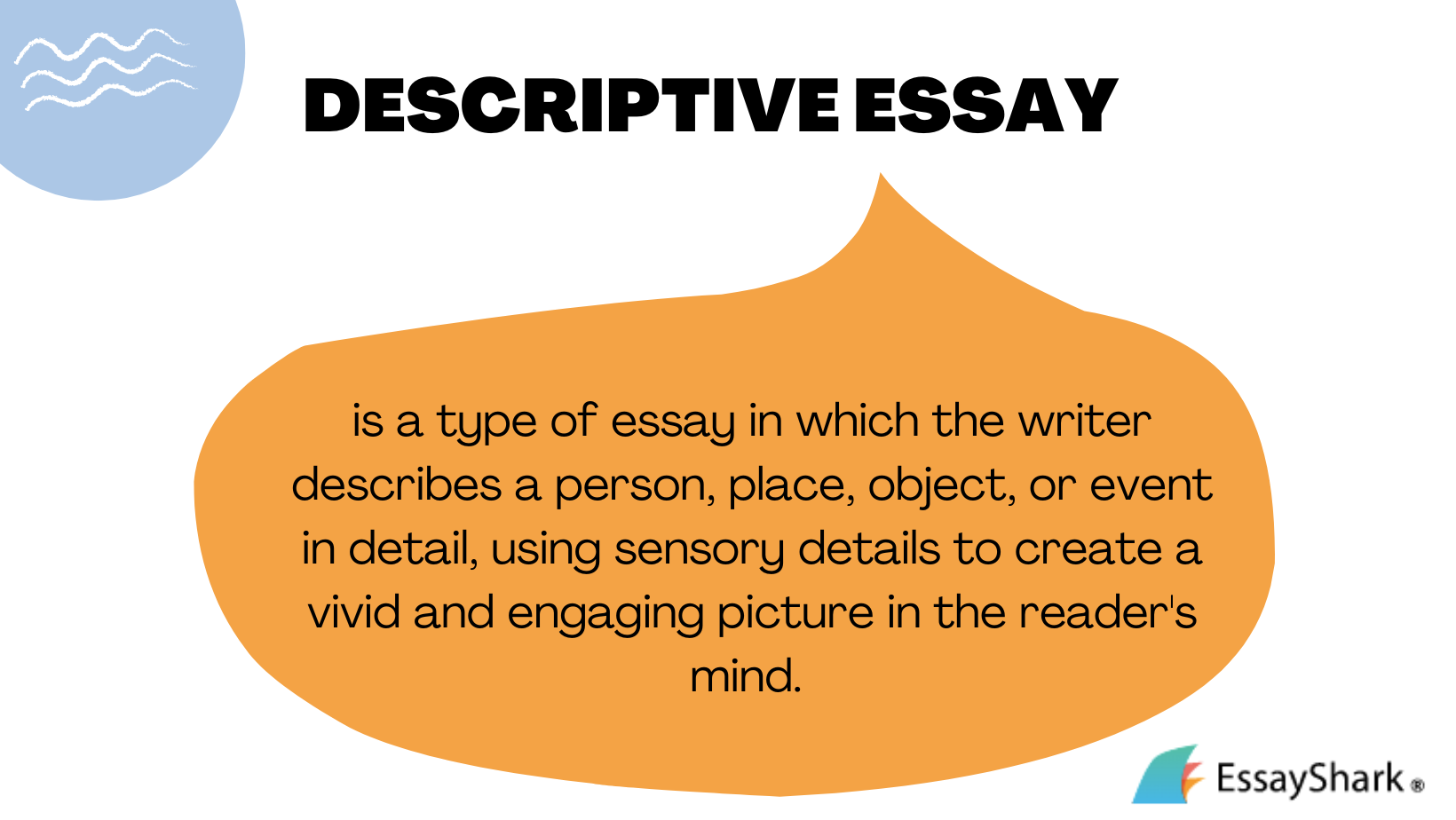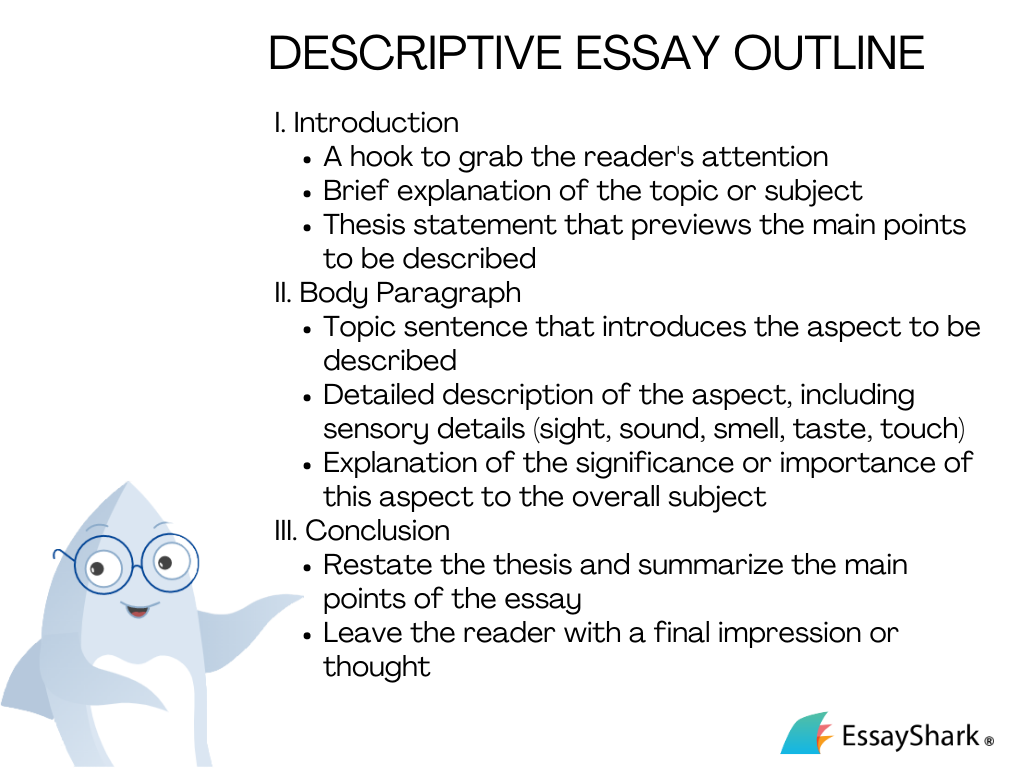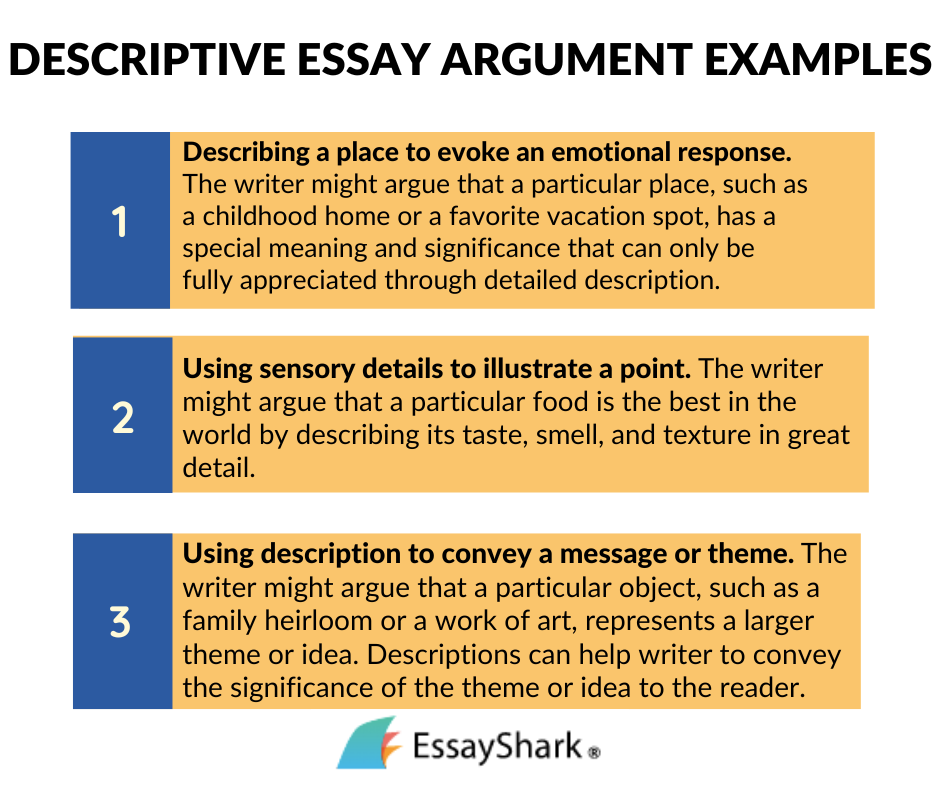Table of contents
Definition of a descriptive essay
A descriptive essay is a type of essay where an author should create a picture in the reader’s mind using the senses like sight, smell, taste, touch, and sound. It is a great success if you can do it, but it is not that easy. We are going to tell you how to write a descriptive essay in the easiest way.

The essence of creating a captivating descriptive essay lies in its structure and organization. An effective piece should have an engaging introduction, solidified body paragraphs, and a thought-provoking conclusion that effortlessly carries the reader from start to finish. Every paragraph must reinforce the main thesis by focusing on one aspect related to the subject matter at hand for maximum lucidity.
All in all, a descriptive essay is an effective tool for authors to express their ideas and feelings about any given topic, truly allowing readers to comprehend the subject matter on a profound level.
How to write a descriptive essay in 8 steps

Step 1. Select a topic.
A good descriptive essay should focus on one object, event, or person. You need to choose a topic that you know in order to describe it in the best possible way. Your task is to illustrate a picture in the reader’s eyes carefully. Structure your essays in a way that your topic makes sense. For example, if you decide to write about a particular event, the paper should be written in chronological order. If you need to describe a person or an object, you need to start generally and then go to more specific details. Also, keep in mind that an introduction sets the tone for the whole paper.
Step 2. Make the thesis statement.
How to write a thesis for a descriptive essay? Writing a thesis statement is the second step after choosing a topic. Throughout the whole essay, this idea should be described in detail. A thesis statement presents the main goal of an essay. It is a sentence that should be included in the introduction.
Step 3. Write the introduction.
How to write an introduction paragraph for a descriptive essay? Here, you should present the main idea and the background information. You need to grab readers’ attention so that they have the desire to read your paper further. Don’t include any details in this part, as you should do it while writing the body of your paper.
Step 4. Deal with senses.
How to start writing a descriptive essay? First of all, you need to take a sheet of paper and draw five columns, each for one sense. These columns will help you to describe all senses in the proper way. Put down feelings that you associate with your topic. Keep in mind that you need to present as many details as possible to support your topic. For writing this type of essay, you can see descriptive objectives, metaphors, and personification.
Step 5. Write body paragraphs.
Write body paragraphs according to the details that you fill in the columns. Use only the most interesting details that you have. Use a separate paragraph for each idea, and write a topic sentence in the beginning of each paragraph. Keep in mind that your body paragraphs should prove the thesis statement.
Step 6. Write the conclusion.
The conclusion serves as a summary of the whole essay. In most cases, it is necessary to restate the thesis statement that you include in the introduction. You should work to write a solid conclusion as well, as it is the last thing that the reader reads and it should leave a good impression. Also, keep in mind that you should not include any new information in the conclusion.
Step 7. Proofread and edit the essay
After you are finished writing your essay, take some time for a break. Take a short rest to clear your mind before proofreading. You will take a look at your paper with fresh eyes and find mistakes more easily. While reading through your essay, think about your reader. Would your essay make sense for you if you were a reader? Is it easy to understand what topic the essay is written on? Are all paragraphs clear and descriptive enough?
You need to check whether the language you use for writing conveys you particular topic. A complete picture should be formed in readers’ minds when they finish reading your essay. Your point of view should be understandable to readers through the details that you use while writing. That’s why reading your essay aloud several times is important. In this way, you can easily identify things in your essay that don’t represent the topic. Also, give your essay to your friend to read it through, as another person’s eyes will be useful in catching mistakes that you can’t see. Ask whether your friend has a clear picture in mind after reading your paper.
Step 8. Finish the work
Correct all the mistakes and typos that you can find in your essay. Also, remove all the cliches that you can find – they are not appropriate for essays. Rewrite weak sentences to enhance your chances to get a high grade. Hand in your paper only after you are confident it is the best essay you can write.
Argument examples for descriptive essays

Descriptive essay example
Our sample about the experience of being inside a space ship will give you some inspiration for writing your own paper. It will help you better understand how a good descriptive essay should be written. After you read the provided sample, you can start brainstorming on your own topic. You will see that this process will become faster and much more effective.
Inside the Space Ship
Scientific and technological progress gave humankind an opportunity to explore outer space and to skip to a principally new level of opportunities and knowledge about the universe. People made a tremendous work in the development of technologies of space exploration from uncontrolled small rocket launching to the present level of utilization of multiple orbital stations and space expeditions. Space vehicles can be inhabited or uninhabited. They are designed for a variety of missions that may include communications, Earth observation, meteorology, navigation, planetary exploration, space tourism, or military purposes (espionage, defense or attack).
Any spaceship consists of several parts: the first one is called mid-deck. It is a location where astronauts sleep, go to the bathroom and have a meal. There is a sleeping compartment in this location, where the astronauts sleep in the bags attached to the wall. The crew cabin is in the form of a truncated cone in which the crew, the life support system, the electrical system, and various equipment are located. It is contained in a pressurized shell formed of a double wall consisting of thick titanium sheets welded together. This shell is covered with an insulator and an outer shell made of a nickel alloy. Each astronaut is lying with his legs bent in a molded bunk and has a hatch in front of him that can be opened manually. The re-entry module is designed to withstand the aerodynamic forces and heat of the atmospheric reentry (Alwes, and Sdunnus, p.1265). The flanks of the module are protected from heat by overlapping metal plates whose composition varies with location. The widest end of the cone, which is the most exposed to heat, is protected by a disk-shaped heat shield consisting of a honeycomb structure filled with ablative material. The reentry module consists of three sections: the rendezvous and landing containing the radar used for rendezvous maneuvers in orbit with another vessel and the parachutes, the section containing the attitude control engines and the crew cabin (Alwes, and Sdunnus, p.1265). The third part of the ship is expendable. This is the service module essentially built around a modified capsule. It will be equipped with solar panels and the mooring system with the Space Station. Finally, it will house all the equipment needed to support life on-board crews and tanks (fuel, oxygen, water).
Concerning the landing phase, each spaceship has multiple variants and modalities for landing, depending on specific mission profiles. The standard mission profile is the conventional landing system that has proven itself time and time again. The spaceship typically uses a system of three open parachutes and several small engines that would be lit a little before landing. This system must allow the craft to land less than 1 kilometer around the intended place on the mainland. It is not excluded that the ship develops an airbag system to reduce the violence of the impact on the ground and that would authorize a landing (Oers et al., p. 34). The spacecraft may or may not have a propulsion subset, depending on whether or not the mission profile requires propulsion. The propulsion system is also necessary for the spacecraft which undertakes momentum maneuvers. The elements of a conventional propulsion subassembly contain fuel, tankage, valves, and ejectors connect to the propulsion subassembly by monitoring the temperature of these components and preheating the tanks and ejectors for maneuvering the spacecraft.
The spacecraft must be built to withstand the passage into the atmosphere and the space environment. It must operate under vacuum with temperatures extending over a wide range (hundreds of degrees Celsius, positive and negative). The thermal control subassembly can be passive, depending on the choice of materials with specific radiating properties (Feiveson, and Kulkarni, p. 332). Active thermal control uses electric heaters and specific triggers such as awnings to control ambient temperatures specific to equipment limits. A space vehicle system has various subsets, depending on the profile of the mission. Space vehicle subsystems may include attitude control and determination, guidance, navigation, and control, communications, command processing and data, power, thermal control, propulsion, structures, and payload. Space vehicles can be equipped to support a crew.
Any spacecraft requires a subsystem of altitude control so that it can be appropriately oriented in space and respond to external torsions and forces adequately. The altitude control subsystem consists of probes and triggers, as well as control algorithms. The altitude control subset allows the appropriate pointing in the interest of the mission (scientific measurement or external intervention), towards the Sun to capture the energy or to present a given space shuttle, towards the Earth or a satellite for communications (Feiveson, and Kulkarni, p. 332).
Thus, any spaceship is a complicated device which shall be carefully prepared to operation in significantly complicated conditions of outer space — regardless different peculiarities in the composition of various types of spaceships they have pretty similar main principles of composition. Various systems of life security are installed inside any spaceship in order to facilitate the mission of the astronauts. If appropriately developed these systems will help the astronauts to make longer and more efficient.
Works Cited
Alwes, D, and H Sdunnus. “Space Debris Aspects In Design And Operation Of A Space Craft – The Programmatic Of An End-To-End Service”. Advances In Space Research, vol 34, no. 5, 2004, pp. 1264-1269. Elsevier BV, doi:10.1016/j.asr.2003.11.015.
Feiveson, Alan H., and Pandurang M. Kulkarni. “Reliability Of Space-Shuttle Pressure Vessels With Random Batch Effects”. Technometrics, vol 42, no. 4, 2000, p. 332. JSTOR, doi:10.2307/1270943.
Oers, Bart van et al. “An Optimisation-Based Space Allocation Routine For The Generation Of Feasible Ship Designs”. Ship Technology Research, vol 56, no. 1, 2009, pp. 31-48. Informa UK Limited, doi:10.1179/str.2009.56.1.005.
Descriptive essay writing prompts

Tips on how to write a descriptive essay
- Before you start describing something, you need to think about the reason for describing that particular thing. This will help you to find the right emotion and the language that you will use in your descriptive writing.
- Inspiring imagination is the main purpose of a descriptive essay. You need to pay attention to details to make your writing more descriptive. You should begin to think about basic things like a book or a hat, and move to harder things, and try to think about all the sensations that they cause. That’s why it is necessary to let your imagination work to the fullest.
- A writer should use colorful words to describe simple things. This is advisable if you want to create a detailed and more vivid picture in the reader’s mind. Don’t be afraid to use words that you rarely use in your everyday life – you can do it if you are writing a descriptive essay.
- Look for synonyms of well-known words. It can help you not only to write an interesting essay, but to improve your vocabulary as well.
- Details are of great importance in descriptive writing. The more details you include in your writing, the more interesting your essay will be to the reader. Your aim here is to become a pro in describing the details.
Writing a descriptive essay should become a rewarding experience to you. Using our guide will enhance the chances that the reader will like your essay. Now, you have all the keys for writing a great descriptive essay. We hope that you will be successful in descriptive writing and can present the paper in a logical and organized sequence. Good luck!









